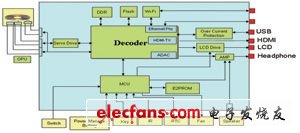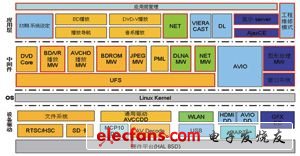At present, it has become a trend that DVD players are gradually replaced by BD players. This trend will also extend to the field of portable CD players. At the 2011 CES show in the United States, Sony, Philips, and Samsung all launched their own portable BD players after Panasonic, which shows that this trend has taken shape. From the perspective of system solutions, this article elaborate on the design and development of portable BD players, aiming to provide a plan and some ideas for domestic counterparts to design products in the future, avoid similar problems, improve development efficiency, and improve product Quality and competitiveness.
System hardware composition
The composition of the entire system hardware is shown in Figure 1, including OPU, decoder, MCU, power and battery management, button and remote control reception, LCD driver, HDMI output, USB, network interface, and each Switch detection. The functions of each component are explained in detail below.

Figure 1 System hardware structure
OPU: Because the BD player needs to be compatible with DVD and CD, this module needs to be equipped with a laser head that can read CD / DVD / BD disc data. Currently, Sanyo, Sony and other products on the market can meet this requirement.
Decoder: The decoder of the BD player needs to be able to decode 1920 & TImes; 1080P full HD video signals, including H.264 / VC-1 / MPEG, etc. The chips of MTK and Broadcom can meet the requirements. The decoder chips listed in this article have built-in Ethernet, HDMI, ADAC and other chips, which are highly integrated. The actual selection is based on the product development needs and specific selection.
MCU: The role of MCU is very important. Because there are many functions of portable players, there is currently no single decoder chip on the market that can complete all portable functions. Therefore, a separate MCU needs to be added to assist the decoder to form the entire system and realize all the functions of the system. The MCU is responsible for handling the buttons and remote control, controlling the LCD driver chip, power management, battery charge and discharge processing, audio power amplifier, etc., and at the same time communicating with the decoder through the communication between the two parties and the transmission of information.
Battery power management: Responsible for the power management of the entire system, including power on / off, adapter / battery switching, battery charge and discharge processing, etc.
Keys and remote control: Handle the input of main body keys and remote control keys.
Switch: responsible for the detection of external switches and headphone insertion.
RTC: Real-time clock module, can be used as actual timing.
FAN: Fan, used for heat dissipation of the system; when the BD player is working, the chip operates at a higher frequency and the power consumption is larger, and an external device is needed to dissipate heat to the main chip.
Over Current ProtecTIon: This chip is used to detect and protect the overcurrent of the USB interface.
USB: It is used to connect external USB devices, expand the functions of the CD player, and play high-definition materials corresponding to network downloads.
Network interface: It has three functions: (1) BD live playback that meets the requirements of BDA; (2) Corresponding to the software network upgrade, the software of the BD player is complex, and the BD specifications are constantly updated. This function can be configured through the network after the product is launched The automatic upgrade function corresponds to market problems, meets the changing needs of the market, reduces consumer input, and improves product competitiveness; (3) corresponds to various network application functions.
System software design
The system is mainly composed of a decoder and an MCU. Coordination and coordination are performed between the decoder and the MCU through communication to complete the functions of the entire system. Therefore, the software design of the system includes three parts: the software design of the decoder part, the software design of the MCU part, and the communication design.
1 Software design of the decoder
The decoder software is constructed on the Linux operating system, including device drivers, middleware and application layer. Adopt modular design concept, divide the system into different levels and different modules according to system function to realize. The operation of different tasks is controlled by starting different processes.
The biggest difference between portable Blu-ray players and similar products in the past is that they can play Blu-ray discs and have rich network functions. The system configuration of the decoder software is shown in Figure 2.

Figure 2 Decoder software system composition
2 MCU software design
The software design of the MCU uses a small operating system to manage two tasks. SubTask is used to communicate with the decoder. MainTask is responsible for all processing except communication. The entire system is divided into driver layer, middle layer and application layer. The driver layer contains hardware devices and OS, including terminal configuration, key input, switch detection, AMP, FAN, RTC, etc .; the middle layer contains various module interfaces that need to be provided to the application layer to achieve specific functions and actions; The functions of the system are divided into modules such as UI and OSD to complete the various functions required by the system. The system configuration of MCU software is shown in Figure 3.

Figure 3 MCU software system composition
3 Communication design
For the communication between the MCU and the decoder, the physical layer can adopt various interface forms, and the UART is selected here. The design of the protocol layer needs to focus on two issues. First, whether all the functions required by the system can be realized, and do not cause errors caused by the incomplete design of the protocol, which will affect the realization of the system functions; second, whether the exception handling mechanism of communication is considered, which affects the reliability of the system, including errors The setting of the number of repeated transmission times, the setting of waiting delay time when the communication is busy, etc.
Power consumption design
Power consumption design is very important for portable products, not only to consider the power consumed during normal operation, but also to consider the power consumption during standby. Power consumption design involves many aspects of the system, including chip selection, circuit design, and so on. Specifically, this system needs to be discussed and verified from the power consumption of the OPU part, the backlight of the LCD, the working power of the decoder, the peripheral circuits, and the power management during standby.
Dc Linear Actuator,Linear Actuator,Linear Actuator 12V,Electric Linear Actuator
Changzhou Sherry International Trading Co., Ltd. , https://www.sherry-motor.com